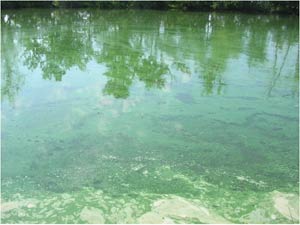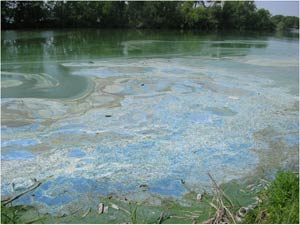
WATER QUALITY PARAMETERS
Total Suspended Solids | Nitrate-Nitrogen | Total Phosphorus | Ortho Phosphorus | E. coli Bacteria
TOTAL PHOSPHORUS (TP)
Includes the amount of phosphorus in solution (reactive) and in particulate form.
Only a portion of the TP is readily available for use in algae growth.
Phosphorus is an essential nutrient for plants and animals and is usually present in natural waters as phosphate. Phosphorus-enriched streams are commonplace in the Minnesota River Basin. Phosphorus stimulates the growth of algae and elevated phosphorus concentrations often lead to eutrophy, which is characterized by undesirably high levels of algal growth. An overabundance of algae and sediment contributes to increased turbidity and reduced light penetration. Water clarity is greatly reduced under these conditions, impairing recreational use and aesthetics of the river environment. Furthermore, algal cells eventually die and their subsequent decomposition consumes in-stream oxygen. This oxygen demand can lower dissolved oxygen in the water and impair the stream’s ability to support aquatic life. Some outbreaks of highly elevated algal growth, termed algal blooms, release toxins into the water. Instances of this have occurred within the Minnesota River Basin and resulted in the death of animals (including pets) that ingested these toxins. Phosphorus arises from both point sources (e.g. municipal and industrial discharges) and non-point sources (e.g. runoff from agricultural lands and urban areas).

